Engineering students use smart materials to design a smart wing
A new aircraft wing design uses smart alloys and heat to position flaps.
 Photo courtesy Jinho Kim
A prototype of the "smart wing" which uses smart alloys and heat from electrical current to position the flaps on an aircraft's wing.
|
A prototype aircraft wing, designed last year by four Temple mechanical engineering seniors to use “memory alloys” and electrical current to control and position the wing’s flaps, was a finalist in the recent Collegiate Inventors Competition, a program of the National Inventors Hall of Fame Foundation and co-sponsored by the Abbott Fund and the U.S. Patent and Trademark Office.
|
|
Their work also will be published in the journal “Aircraft Engineering and Aerospace Technology” in January 2008. “A conventional aircraft wing uses hydraulics and an electronic motor to move the flaps into their proper positions for ascent and descent, so it is very heavy and noisy,” said Kim, who is now a graduate student in Temple’s engineering program. “We replaced those with these ‘smart materials’ that we can manipulate through applied heat using electrical current.”
|
|